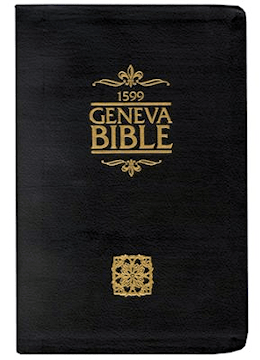Textus Receptus Bibles
Geneva Bible 1560/1599
| 12:1 | And the me of Ephraim gathered themselues together, and went Northwarde, and saide vnto Iphtah, Wherefore wentest thou to fight against the children of Ammon, and diddest not call vs to goe with thee? we will therefore burne thine house vpon thee with fire. |
| 12:2 | And Iphtah said vnto them, I and my people were at great strife with the children of Ammon, and when I called you, ye deliuered me not out of their handes. |
| 12:3 | So when I sawe that ye deliuered me not, I put my life in mine hands, and went vpon the children of Ammon: so the Lord deliuered them into mine handes. Wherefore then are ye come vpon me nowe to fight against me? |
| 12:4 | Then Iphtah gathered all the men of Gilead, and fought with Ephraim: and the men of Gilead smote Ephraim, because they said, Ye Gileadites are runnagates of Ephraim among the Ephraimites, and among the Manassites. |
| 12:5 | Also the Gileadites tooke the passages of Iorden before the Ephraimites, and when the Ephraimites that were escaped, saide, Let me passe, then the men of Gilead said vnto him, Art thou an Ephraimite? If he said, Nay, |
| 12:6 | Then said they vnto him, Say nowe Shibboleth: and he said, Sibboleth: for he could not so pronounce: then they tooke him, and slewe him at the passages of Iorden: and there fel at that time of the Ephraimites two and fourtie thousand. |
| 12:7 | And Iphtah iudged Israel sixe yeere: then dyed Iphtah the Gileadite, and was buryed in one of the cities of Gilead. |
| 12:8 | After him Ibzan of Beth-lehem iudged Israel, |
| 12:9 | Who had thirtie sonnes and thirtie daughters, which he sent out, and tooke in thirtie daughters from abroade for his sonnes. and he iudged Israel seuen yeere. |
| 12:10 | Then Ibzan died, and was buryed at Bethlehem. |
| 12:11 | And after him iudged Israel Elon, a Zebulonite, and he iudged Israel tenne yeere. |
| 12:12 | Then Elon the Zebulonite dyed, and was buryed in Aijalon in the countrey of Zebulun. |
| 12:13 | And after him Abdon the sonne of Hillel the Pirathonite iudged Israel. |
| 12:14 | And he had fourty sonnes and thirtie nephewes that rode on seuentie assecoltes: and he iudged Israel eight yeeres. |
| 12:15 | Then dyed Abdon the sonne of Hillel the Pirathonite, and was buryed in Pirathon, in ye lande of Ephraim, in the Mount of the Amalekites. |

Geneva Bible 1560/1599
The Geneva Bible is one of the most influential and historically significant translations of the Bible into English, preceding the King James translation by 51 years. It was the primary Bible of 16th century Protestantism and was the Bible used by William Shakespeare, Oliver Cromwell, John Knox, John Donne, and John Bunyan. The language of the Geneva Bible was more forceful and vigorous and because of this, most readers strongly preferred this version at the time.
The Geneva Bible was produced by a group of English scholars who, fleeing from the reign of Queen Mary, had found refuge in Switzerland. During the reign of Queen Mary, no Bibles were printed in England, the English Bible was no longer used in churches and English Bibles already in churches were removed and burned. Mary was determined to return Britain to Roman Catholicism.
The first English Protestant to die during Mary's turbulent reign was John Rogers in 1555, who had been the editor of the Matthews Bible. At this time, hundreds of Protestants left England and headed for Geneva, a city which under the leadership of Calvin, had become the intellectual and spiritual capital of European Protestants.
One of these exiles was William Whittingham, a fellow of Christ Church at Oxford University, who had been a diplomat, a courtier, was much traveled and skilled in many languages including Greek and Hebrew. He eventually succeeded John Knox as the minister of the English congregation in Geneva. Whittingham went on to publish the 1560 Geneva Bible.
This version is significant because, it came with a variety of scriptural study guides and aids, which included verse citations that allow the reader to cross-reference one verse with numerous relevant verses in the rest of the Bible, introductions to each book of the Bible that acted to summarize all of the material that each book would cover, maps, tables, woodcut illustrations, indices, as well as other included features, all of which would eventually lead to the reputation of the Geneva Bible as history's very first study Bible.